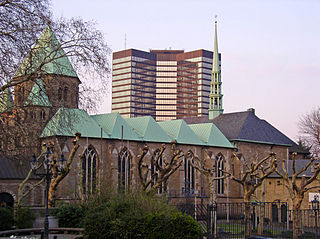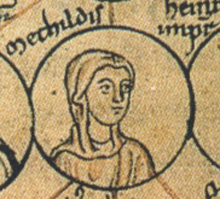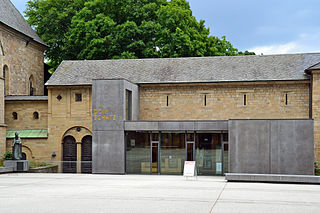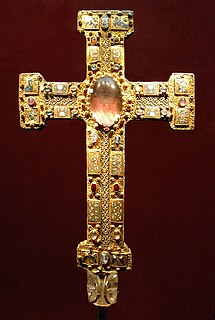
Theophanu was empress of the Holy Roman Empire by marriage to Emperor Otto II, and regent of Empire during the minority of their son, Emperor Otto III, from 983 until her death in 991. She was the niece of the Byzantine Emperor John I Tzimiskes.

Year 1058 (MLVIII) was a common year starting on Thursday of the Julian calendar.
Ezzo, sometimes called Ehrenfried, a member of the Ezzonid dynasty, was Count Palatine of Lotharingia from 1015 until his death. As brother-in-law of Emperor Otto III, father of Queen Richeza of Poland and several other illustrious children, he was one of the most important figures of the Rhenish history of his time.
Theophano (Θεοφανώ) may refer to:

Herman II, a member of the Ezzonid dynasty, was Archbishop of Cologne from 1036 until his death.

The Golden Madonna of Essen is a sculpture of the Virgin Mary and the infant Jesus. It is a wooden core covered with sheets of thin gold leaf. The piece is part of the treasury of Essen Cathedral, formerly the church of Essen Abbey, in North Rhine-Westphalia, Germany, and is kept on display at the cathedral.

Essen Abbey was a monastery of secular canonesses for women of high nobility in Essen, Germany. It was founded about 845 by the Saxon Altfrid, later Bishop of Hildesheim and saint, near a royal estate called Astnidhi, which later gave its name to the religious house and to the town. The first abbess was Altfrid's kinswoman, Gerswit.

Essen Minster, since 1958 also Essen Cathedral is the seat of the Roman Catholic Bishop of Essen, the "Diocese of the Ruhr", founded in 1958. The church, dedicated to Saints Cosmas and Damian and the Blessed Virgin Mary, stands on the Burgplatz in the centre of the city of Essen, Germany.

Adelaide I, a member of the royal Ottonian dynasty was the second Princess-abbess of Quedlinburg from 999, and Abbess of Gernrode from 1014, and Abbess of Gandersheim from 1039 until her death, as well as a highly influential kingmaker of medieval Germany.

Sophia I, a member of the royal Ottonian dynasty, was Abbess of Gandersheim from 1002, and from 1011 also Abbess of Essen. The daughter of Emperor Otto II and his consort Theophanu, she was an important kingmaker in medieval Germany.

Matilda of Germany or Matilde of Saxony was the third daughter of Otto II, Holy Roman Emperor and his wife, Empress Theophanu.

The Essen Cathedral Treasury is one of the most significant collections of religious artworks in Germany. A great number of items of treasure are accessible to the public in the treasury chamber of Essen Minster. The cathedral chapter manages the treasury chamber, not as a museum as in some places, but as the place in which liturgical implements and objects are kept, which continued to be used to this day in the service of God, so far as their conservation requirements allow.

The Cross of Otto and Mathilde, Otto-Mathilda Cross, or First Cross of Mathilde is a medieval crux gemmata processional cross in the Essen Cathedral Treasury. It was created in the late tenth century and was used on high holidays until recently. It is named after the two persons who appear on the enamel plaque below Christ: Otto I, Duke of Swabia and Bavaria and his sister, Mathilde, the abbess of the Essen Abbey. They were grandchildren of the emperor Otto I and favourites of their uncle, Otto II. The cross is one of the items which demonstrate the very close relationship between the Liudolfing royal house and Essen Abbey. Mathilde became Abbess of Essen in 973 and her brother died in 982, so the cross is assumed to have been made between those dates, or a year or two later if it had a memorial function for Otto. Like other objects in Essen made under the patronage of Mathilde, the location of the goldsmith's workshop is uncertain, but as well as Essen itself, Cologne has often been suggested, and the enamel plaque may have been made separately in Trier.

Mathilde was Abbess of Essen Abbey from 973 to her death. She was one of the most important abbesses in the history of Essen. She was responsible for the abbey, for its buildings, its precious relics, liturgical vessels and manuscripts, its political contacts, and for commissioning translations and overseeing education. In the unreliable list of Essen Abbesses from 1672, she is listed as the second Abbess Mathilde and as a result, she is sometimes called "Mathilde II" to distinguish her from the earlier abbess of the same name, who is meant to have governed Essen Abbey from 907 to 910 but whose existence is disputed.

The Cross of Mathilde is an Ottonian processional cross in the crux gemmata style which has been in Essen in Germany since it was made in the 11th century. It is named after Abbess Mathilde who is depicted as the donor on a cloisonné enamel plaque on the cross's stem. It was made between about 1000, when Mathilde was abbess, and 1058, when Abbess Theophanu died; both were princesses of the Ottonian dynasty. It may have been completed in stages, and the corpus, the body of the crucified Christ, may be a still later replacement. The cross, which is also called the "second cross of Mathilde", forms part of a group along with the Cross of Otto and Mathilde or "first cross of Mathilde" from late in the preceding century, a third cross, sometimes called the Senkschmelz Cross, and the Cross of Theophanu from her period as abbess. All were made for Essen Abbey, now Essen Cathedral, and are kept in Essen Cathedral Treasury, where this cross is inventory number 4.

The Cross with large enamels, or Senkschmelz Cross, known in German as the Senkschmelzen-Kreuz or the Kreuz mit den großen Senkschmelzen is a processional cross in the Essen Cathedral Treasury which was created under Mathilde, Abbess of Essen. The name refers to its principal decorations, five unusually large enamel plaques made using the senkschmelz technique, a form of cloisonné which looks forward to champlevé enamel, with a recessed area in enamel surrounded by a plain gold background, and distinguishes it from three other crosses of the crux gemmata type at Essen. The cross is considered one of the masterpieces of Ottonian goldsmithing.

The Cross of Theophanu is one of four Ottonian processional crosses in the Essen Cathedral Treasury and is among the most significant pieces of goldwork from that period. It was donated by Theophanu, Abbess of Essen, who reigned from 1039 to 1058.

The Essen Crown is an Ottonian golden crown in the Essen Cathedral Treasury. It was formerly claimed that it might have been the crown with which the three-year-old Otto III was crowned King of the Romans in 983, which is the source of its common name, the Childhood Crown of Otto III. However, this idea most probably derives from the wishful thinking of early twentieth century historians of Essen and it is now widely rejected. However it is certainly the oldest surviving lily crown in the world.

The Catholic parish church of St. Johann Baptist is a Gothic hall church in Essen, dedicated to John the Baptist, which stands on Kettwiger Straße, the main street of Essen, in front of Essen Minster, to which it is connected. On account of its position and the fact that its spire towers over the Minster, visitors often mistake it for part of the Minster.


















